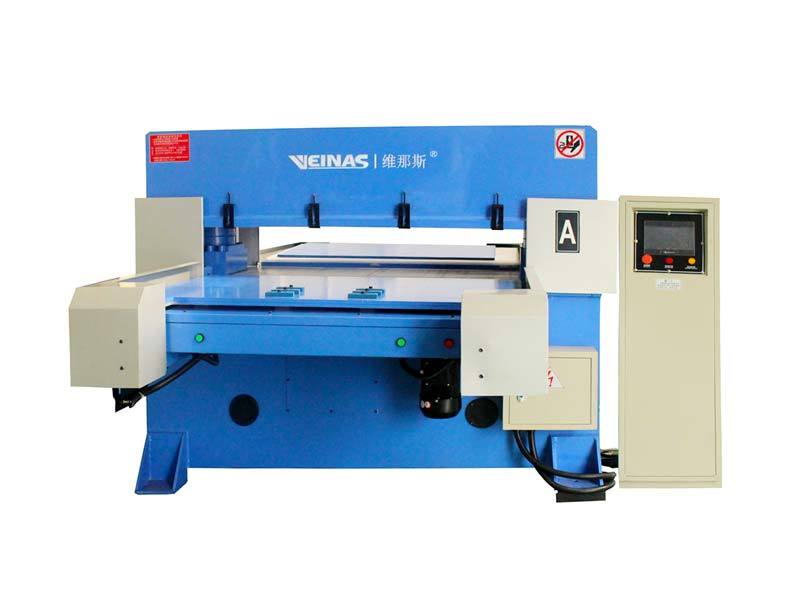Heat treatment is to improve the mechanical properties of the material, eliminate the residual stress and improve the machinability of the metal. According to the different purposes of heat treatment, heat treatment process can be divided into two categories: preparation heat treatment and final heat treatment.
1, prepare heat treatment
The purpose of the prepara heat treatment is to improve the processing performance, eliminate the internal stress and prepare the metallographic structure for the final heat treatment. The heat treatment processes are annealing, normalizing, aging, quenching and tempering, etc.
(1) aging treatment is mainly used to eliminate the internal stress produced in the manufacturing and machining of hydraulic die cutting machine. In order to avoid too much transport work, for the general accuracy of the parts, in the finishing process before the arrangement of A. However, high precision parts, should be arranged two or several aging treatment process. Simple parts can not be generally aging treatment. In addition to casting, precision parts for some low rigidity, in order to eliminate the internal stress generated during machining, stable machining precision, often arranged several times in the aging treatment between roughing semi finishing. Some shaft parts processing, straightening process should be arranged after aging treatment.
(2) the annealing and normalizing annealing and normalizing of the vertical cutting machine for the blank after heat treatment. Carbon steel and alloy steel carbon content more than 0.5%, in order to reduce the hardness of easy cutting, often by annealing treatment; carbon content less than 0.5% carbon steel and alloy steel, in order to avoid the low hardness of cutting and sticking knife by normalizing treatment. Annealing and normalizing can refine grain and uniform structure, and prepare for later heat treatment. Annealing and normalizing are often arranged prior to rough machining and rough machining.

(3) and high temperature tempering is tempering after quenching, it can obtain uniform tempered sorbite structure to reduce deformation of surface quenching and nitriding treatment for the future, it can also be used for pre heat treatment tempering.
Due to the excellent mechanical properties of the parts after quenching and tempering, the parts with high hardness and wear resistance are not required, and can also be used as the final heat treatment process.
2, the final heat treatment
The purpose of the final heat treatment is to improve the mechanical properties such as hardness, wear resistance and strength.
(1) carburizing carburizing and quenching for low carbon steel and low alloy steel, improve the carbon content of the surface, after quenching to obtain high surface hardness, but the heart still keep a certain strength and toughness and plasticity. Carburizing and carburizing. Local carburizing to non carburizing part of the measures to be taken to prevent seepage (copper plated or impermeable material). Due to the large deformation of carburizing and quenching, and the carburizing depth is generally between 0.5~ 2mm, so the carburizing process is generally arranged in the semi finishing and finishing. The technological process is as follows: cutting forging, normalizing, roughing, semi finishing, carburizing, quenching and finishing.
When the carburizing parts of the local carburizing parts are used to increase the allowance, the process of removing the excess carburized layer shall be arranged after carburizing.
(2) quenching with surface quenching and quenching. The surface quenching is widely used because of the deformation, oxidation and decarburization, and the surface quenching has the advantages of high external strength, good wear resistance, and good toughness and impact resistance. In order to improve the mechanical properties of surface hardened parts, heat treatment, such as quenching and tempering, normalizing, and so on, should be used as the initial heat treatment. The general technological route is as follows: blanking, forging, normalizing, annealing, rough machining, quenching and tempering, semi finishing, surface hardening, finishing.
(3) nitriding is a method of treating nitrogen atoms to penetrate a metal surface to obtain a layer of nitrogen containing compounds. Nitriding layer can improve the surface hardness, wear resistance, fatigue strength and corrosion resistance. Because of the low temperature nitriding treatment, small deformation, and the nitriding layer is thin (less than 0.6~ 0.7mm), should be arranged after nitriding process, to reduce deformation of nitriding, the cutting should be eliminated after high temperature tempering stress.
Copyright 2018 Zhuhai Huasu | All Design Rights Reserved by www.veinasmachine.com
Hello, please leave your name and email here before chat online so that we won't miss your message and contact you smoothly.